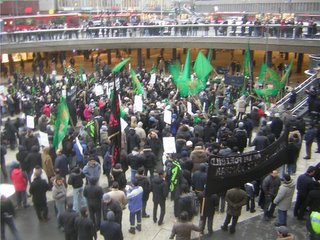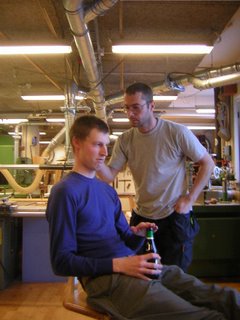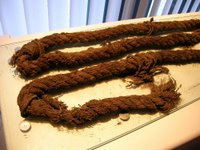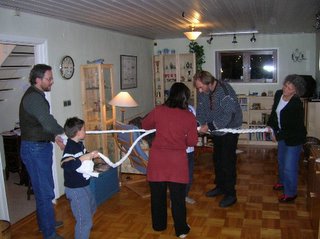Regrettably, there comes a time when every sailor must quit the sea and go ashore...
My time aboard the 1915 icebreaker Sankt Erik has come to an end through a confluence of circumstances. Preparations are getting underway to get the ship opened for the tourist season with exhibit installations in the cargo hold, cafe workers taking over the galley, and the restoration crew rushing to finish the remaining carpentry work on a few compartments back aft. Meanwhile, there is pressure to clear the ship's staterooms before the spate of spring conferences held onboard commences. Then there is the fortunate circumstance that arrangements for my apartment in Bagarmossen ("Begger's Bog," on the south side of the city) have gone through unexpectedly quickly. Thus I have packed my belongings into my sailbag and stepped ashore...
 It was just barely over a month ago that I first walked up the gangplank of the Sankt Erik. Since then, the sturdy little ship has truly become my home, the place where I am content and at ease. She has been a refuge for me in this foreign city, a small floating world composed of familiar sights and smells, curves and motions, and the nautical fittings typical of any ship anywhere--even ships back home. Indeed, Sankt Erik has truly come to embody the old Swedish saying "bort men hemma" (gone but home). She has become my second home--or more accurately--my ship. We never went to sea, yet Sankt Erik has become one of my ships like Cynosura, Wawona, or Corwith Cramer. You put in enough time working on a vessel--investing you time and energy, your concerns and your aspirations--and an unbreakable affinity is formed between man and ship. It is that age-old connection that makes it so tough to turn one's back to and go ashore.
It was just barely over a month ago that I first walked up the gangplank of the Sankt Erik. Since then, the sturdy little ship has truly become my home, the place where I am content and at ease. She has been a refuge for me in this foreign city, a small floating world composed of familiar sights and smells, curves and motions, and the nautical fittings typical of any ship anywhere--even ships back home. Indeed, Sankt Erik has truly come to embody the old Swedish saying "bort men hemma" (gone but home). She has become my second home--or more accurately--my ship. We never went to sea, yet Sankt Erik has become one of my ships like Cynosura, Wawona, or Corwith Cramer. You put in enough time working on a vessel--investing you time and energy, your concerns and your aspirations--and an unbreakable affinity is formed between man and ship. It is that age-old connection that makes it so tough to turn one's back to and go ashore.
 I have gotten to know Sankt Erik from the bridge to the bilge...
I have gotten to know Sankt Erik from the bridge to the bilge...
 (standing in the propellershaft-tunnel)
(standing in the propellershaft-tunnel)
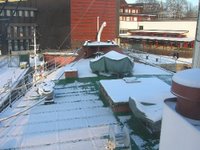 ...and from stem to stern...
...and from stem to stern...
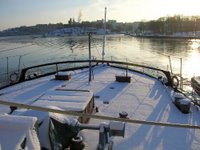
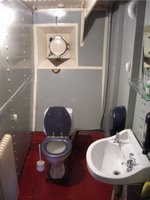
...I have developed a peculiar (and slightly masochistic) pride in unflinchinly marching into the icy head every morning...
 ...and in braving the short but perilously slick forray across her snow-covered decks to the gangway.
...and in braving the short but perilously slick forray across her snow-covered decks to the gangway.
 Yet I have also enjoyed the many pleasures Sankt Erik offered from the start. There was the relaxing calm that came with gazing through the dayroom porthole at the sun dancing over the stanchions and under the boatdeck as it reflected off the water and drifting ice below...
Yet I have also enjoyed the many pleasures Sankt Erik offered from the start. There was the relaxing calm that came with gazing through the dayroom porthole at the sun dancing over the stanchions and under the boatdeck as it reflected off the water and drifting ice below...
 ...and the delight of walking the decks of this ship--a near caricature of a steamer in her religious adherence to the sterotypical assortment of rivet heads, bitts, steam winches, the squat funnel, and the clustered lifeboats.
...and the delight of walking the decks of this ship--a near caricature of a steamer in her religious adherence to the sterotypical assortment of rivet heads, bitts, steam winches, the squat funnel, and the clustered lifeboats.
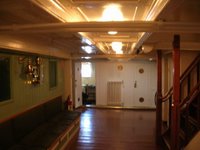 Below decks was home--a very luxury home. From its enormous foyer...
Below decks was home--a very luxury home. From its enormous foyer...
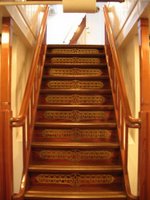 ...to its brass-decorated 'Grand Staircase'...
...to its brass-decorated 'Grand Staircase'...
 ...and the elegantly decorated wardroom where I spent many comfortable hours attempting to reconstruct the swedish language.
...and the elegantly decorated wardroom where I spent many comfortable hours attempting to reconstruct the swedish language.
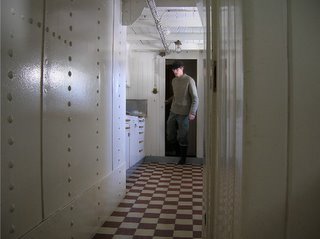 ...And there were those many other hours I spent exploring the ship...
...And there were those many other hours I spent exploring the ship...
 ...back and forth through passageways, up and down ladders, around piles of spare parts and over miles of twisting pipe...
...back and forth through passageways, up and down ladders, around piles of spare parts and over miles of twisting pipe...
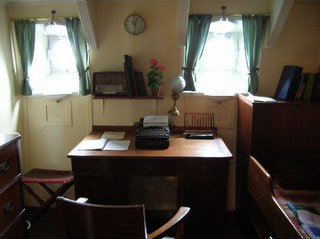 I poked about the restored period cabins...
I poked about the restored period cabins...
 ...and through the lower decks aft where the restoration crews have been laboring...
...and through the lower decks aft where the restoration crews have been laboring...
 ...and into the countless hidden corners of the ship like the lazarette where a fascinating multitude of lines, equipment, tools, and spare parts are stowed away.
...and into the countless hidden corners of the ship like the lazarette where a fascinating multitude of lines, equipment, tools, and spare parts are stowed away.
 But is the little things I know I will miss most--the rythmic pulse of Finngrundet's beacon light shining through the port side portholes,...
But is the little things I know I will miss most--the rythmic pulse of Finngrundet's beacon light shining through the port side portholes,...
 The clatter of bow thrusters resonating through the water as the big Viking Line ships from Finland come in, the dull throbbing of the steamer Saltsjön chugging by (left of cruise ship), or the muttering of the ducks and swans swimming between the ice floes beside the ship.
The clatter of bow thrusters resonating through the water as the big Viking Line ships from Finland come in, the dull throbbing of the steamer Saltsjön chugging by (left of cruise ship), or the muttering of the ducks and swans swimming between the ice floes beside the ship.
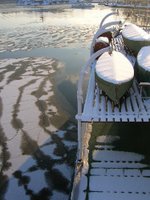 ...and I will miss the exciting sounds of ice grinding against the steel plating when a wake from a passing boat surges along the hull.
...and I will miss the exciting sounds of ice grinding against the steel plating when a wake from a passing boat surges along the hull.
 and quite naturally, the ever-present smell of cookies in the restoration crew's dayroom...
and quite naturally, the ever-present smell of cookies in the restoration crew's dayroom...
 ...Even more, there are the delicately enchanting patterns of snow gathering and melting on the ship, elequently marking a valve wheel, a mooring line, or even a hidden deck beam in a striking contrast of black and white.
...Even more, there are the delicately enchanting patterns of snow gathering and melting on the ship, elequently marking a valve wheel, a mooring line, or even a hidden deck beam in a striking contrast of black and white.
But all these simple pleasures Sankt Erik has provided me--and hopefully, to you as well--must now be locked away in memory. Spring, then summer and the bustling tourist season are approaching and Sankt Erik will become a very different place. Already elegant but racous parties are being held in the wardroom by night and the restoration crew is unleashing a cacophanous army of powertools by day. Soon the galley will be swarming with restaurant staff.

The wardroom carefully and ornately prepared for a party
In some respects, I wish I could stay and see the ship come alive again after a long winter. Like Captain Ericson says in The Cruel Sea, he prefers the ship with the bustle of shipboard life--the humming of the dynamos far below decks, the klunking of the on-duty watch's boots on the ladders, and the distant roars of laughter from the mess deck. The quiet and still ship he finds in the shipyard seemed cold and lifeless, the way Sankt Erik has been.
But at the same time, there is the realization that perhaps I got to live aboard during the best time of the year to do so. The noises of the coming months will not be those of a living icebreaker, but rather those of a ship converted into a floating tourist attraction. Moreover, the presence of persistently nosy, noisy crowds could make life aboard somewhat less than relaxing and probably obstruct my indulgent pass-time of exploring the innards of the mighty ship.
On my last day aboard the galley sink froze up. Ice in the drain again. Determined to clear it, I took a portable heater, an extension cord, and a flashlight and went looking for the end of the drainpipe.
When this happened in my stateroom two weeks ago, an hour of warm air against the copper pipe where it passed through the hull was successful in melting the ice that had formed there.
Aiming to do the same with the galley sink, I first had to find the through-hull where the pipe met the icy winds of the harbor. The fact that the galley is situated amidships near her widest section meant that finding the correct through-hull required an extensive exploration of the engine and boiler rooms--much to my delight. Naturally, the engine and boiler rooms are already a maze of twisting pipes. Somewhere among them had to be my drinapipe...
I poked into the aft engine room with my flashlight but it was too far aft anyway. So I squeezed past the watertight door into the boiler room, wound my way past the No. 1 and No. 3 boilers and began scanning the pipes overhead. They wound about in every direction, curling around eachother and over the deck gratings above. In pitch dark save for my feeble flashlight, I climbed the bare steel-rung ladders up two more 'decks' through the boiler room. Finally there was a solid deck overhead--probably the main deck and therefore, just below the galley level... but it seemed I was now too far forward.
 Top of the No. 3 boiler.
Top of the No. 3 boiler.
I went back down the ladders in search of a route that would take me upward in the after section of the boiler room. Tucked behind the No. 1 boiler I found a small ladder leading up to a narrow catwalk grating. The ladder was squeezed into a tight space between the boiler and a bulkhead such that I could barely wedge myself in to ascend the ladder. Once on the grating above, perched between the tops of the two enormous boilers (I wondered how anyone could have withstood the heat on this grating when she was operating) I found another ladder arching over the boiler and passing through a small hole in the solid deck plating above. Squeezing through I found myself in a space that I assumed had to be directly beneath the galley. Scanning the ceiling once again, I soon found the galley drains, five of them all in the correct orientation to eachother. I had found it!
But then I had to follow the pipe to the through-hull. I traced it along until the pipe disappeared into the port rocker tank (a large ballast tank that would be rapidly filled and drained to start the ship rolling side-to-side so as to break free of the ice if she became stuck). Damn... But then I noticed an inspection port that had been opened. Shining my light through I could see the through-hull 15 feet away. I passed through heavy steel plating, the exterior hull of the ship!
Assessing my own dimensions relative to the inspection port, I took the heater and extension cord and wriggled through the tiny opening. Once inside the tank, I was able to stand up straight for the first time in a half hour; it was really quite spacious in there...
Moving toward the through-hull, I passed a sizable opening in the floor connecting to a lower portion of the tank, some two decks deep. It was like one of those terrifyingly jagged, deep caves you find in a lavafield. Skirting around it I set up my equipment beside the pipe and wriggled my way back out into the light of day in the galley.
When I came topside I found that I was smeared from head to toe with oil, grease, and rust. My hands were black as coal and for a moment I felt like I was have a true steamship experience...though the boiler room was eerily cold and still.
A half hour later the sink gurgled and drained. Success!! Satisified that I had done the ship one final service before leaving, I scurried below one last time, crawled back into the rocker tank and retreived the equipment. Despite my elation at having defeated the ice in the nearly-inaccessible pipe, I refrained from telling Magnus. Somehow it seemed that as the restoration chief, the last thing he wanted to hear about was a guest researcher clamboring around in the dark on creaky catwalks trying to find hidden pipes inside water tanks.
But it was a very good last day aboard...
 So, farewll to a fine ship. I am moving ashore...
So, farewll to a fine ship. I am moving ashore...
 So, with a parting salute to the colors and a few notes of "Johnny, Leave Her" on the concertina, I marched down the gangplank.
So, with a parting salute to the colors and a few notes of "Johnny, Leave Her" on the concertina, I marched down the gangplank.


 On closer inspection of the carriage, it is possible to see through the waxy layers of protective PEG (polyethalineglycol) to the fascinating patterns eroded into the wood by the incessant, slow sand-blasting of the currents during the 333 years on the harbor bottom.
On closer inspection of the carriage, it is possible to see through the waxy layers of protective PEG (polyethalineglycol) to the fascinating patterns eroded into the wood by the incessant, slow sand-blasting of the currents during the 333 years on the harbor bottom. 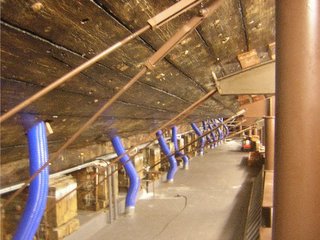 One of the exciting parts of choosing a carriage is the fact that all the assembled carriages are all stored underneath the Vasa. This shot shows the Vasa's keel and lower planking as well as the steel cradle suporting the ship. The blue hoses pump climate-controlled air into the ship's hold to prevent molding (Don't worry, Vasamuseet did not cut the holes, that was an ethically questionable decision made by the excavation team to drain the mud and water out).
One of the exciting parts of choosing a carriage is the fact that all the assembled carriages are all stored underneath the Vasa. This shot shows the Vasa's keel and lower planking as well as the steel cradle suporting the ship. The blue hoses pump climate-controlled air into the ship's hold to prevent molding (Don't worry, Vasamuseet did not cut the holes, that was an ethically questionable decision made by the excavation team to drain the mud and water out).

